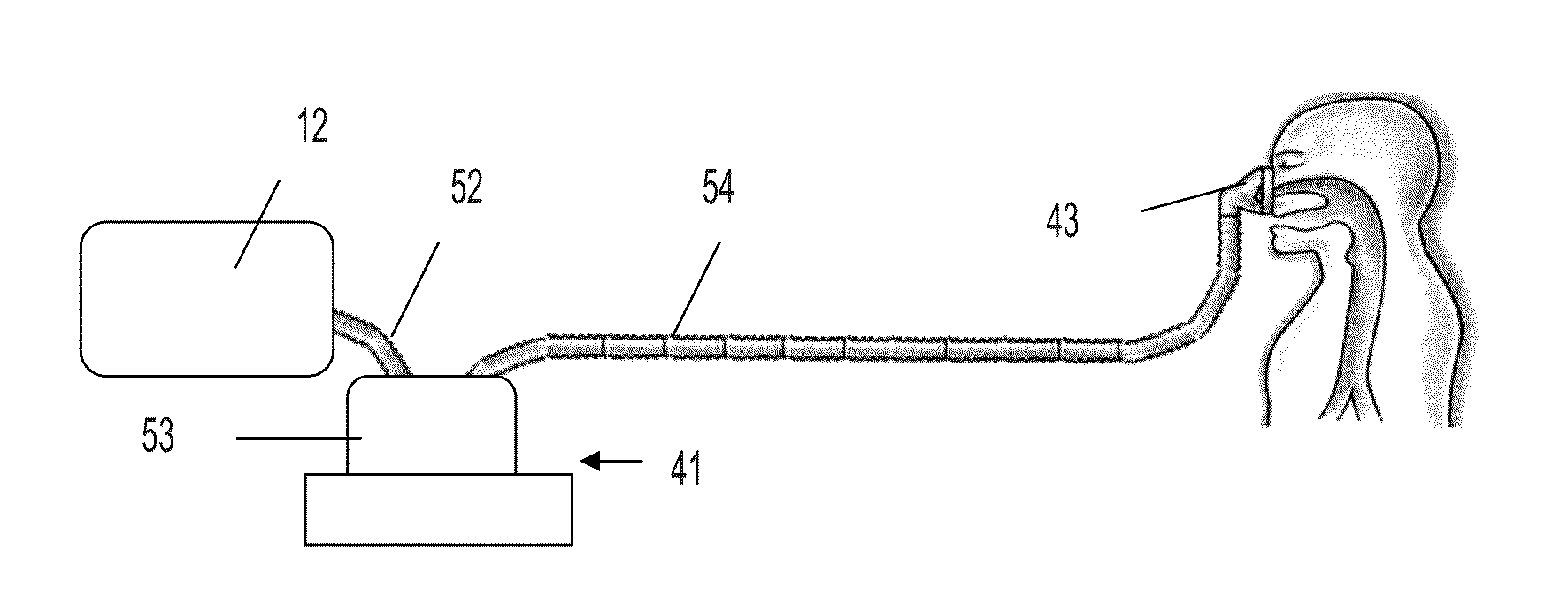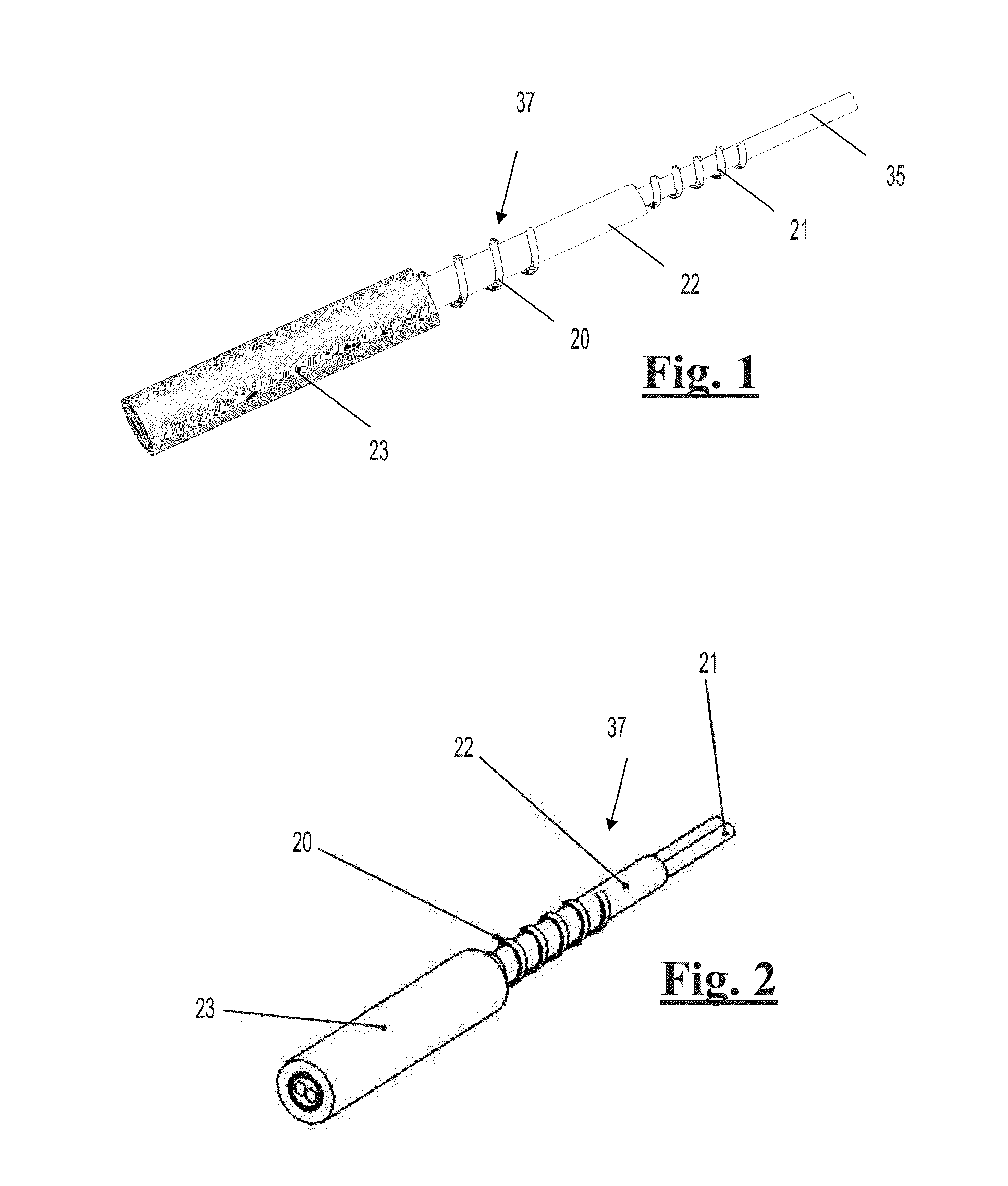Respiratory system
a technology of respirator and airway, applied in the field of respirator, can solve the problems of insufficient heat and moisture in the airway, condensation of breathable gas, and high potential side effects, and achieve the effect of reducing overheating
- Summary
- Abstract
- Description
- Claims
- Application Information
AI Technical Summary
Benefits of technology
Problems solved by technology
Method used
Image
Examples
experiment 1
Air flow: 10
[0211]
HeatingHeattingT ambient = 13-14° C.Setting Inlet Outlet Other Td ambient = 9-9.5° C.HHHosehosemofificationsT wTTd19offon4525.418.329onon4525.921.439ononwith plug in4528.324.445ononwith plug in38.627.121.6
Line 1-Line 2: Effect of Heating the Inlet Air:
[0212]When the inlet air was not heated, the dewpoint of the outlet air is 18.3° C. (equivalent to 15.6 mg water / liter air). With the heating system in the inlet hose on, the dewpoint is increased to 21.4° C. or 18.7 mg / l. This is an increase of 20% in vapor content. Note that heating the inlet air does not have a significant effect on the outlet air temperature.
Line 2-Line 3: Effect of Air Turbulence on Water Surface
[0213]A plug was mounted on the inlet on the inside of the HH in order to create turbulence on the water surface in the reservoir. The plug is also expected to have an effect on the air flow speed (air flow reduction).
[0214]As a result of mounting the plug, another 3° C. dewpoint increase was noticed. The...
experiment 2
Air flow: 10
[0219]
HeatingHeattingT ambient = 13-14° C.SettingInlet Outlet Other Td ambient = 9-9.5° C.HHHosehosemofificationsTwTTd9onon4834.722.29ononwith baffles4835.825.29ononwith plug + baffles4836.531.3
[0220]Confirmation of Effect of Increased Residence Time and Water Surface Turbulence:
[0221]Two baffles were introduced in the HH to force the air to circulate over the heated water surface: increase in dewpoint of 3° C. Adding the plug (restricted air flow+turbulence on water surface) resulted in another 6° C. increase in dewpoint.
experiment 3
Air flow: 10
[0222]
HeatingHeattingT ambient = 23° C.SettingInlet Outlet Other Td ambient = 9-10° C.HHHosehosemofificationsTwTTd9offoffwith baffles4829.3229onoffwith baffles4829.2239ononwith baffles4836.222.9
[0223]Confirmation of effect of heated inlet air: dewpoint increase of 1° C. This increase is significant but less explicit when compared to more extreme ambient temperature of 13-14° C.
[0224]Very obvious effect of heating the outlet air in the outlet hose: temperature increased with 7° C.
PUM
| Property | Measurement | Unit |
|---|---|---|
| temperature | aaaaa | aaaaa |
| temperature | aaaaa | aaaaa |
| temperatures | aaaaa | aaaaa |
Abstract
Description
Claims
Application Information
 Login to View More
Login to View More - R&D
- Intellectual Property
- Life Sciences
- Materials
- Tech Scout
- Unparalleled Data Quality
- Higher Quality Content
- 60% Fewer Hallucinations
Browse by: Latest US Patents, China's latest patents, Technical Efficacy Thesaurus, Application Domain, Technology Topic, Popular Technical Reports.
© 2025 PatSnap. All rights reserved.Legal|Privacy policy|Modern Slavery Act Transparency Statement|Sitemap|About US| Contact US: help@patsnap.com



